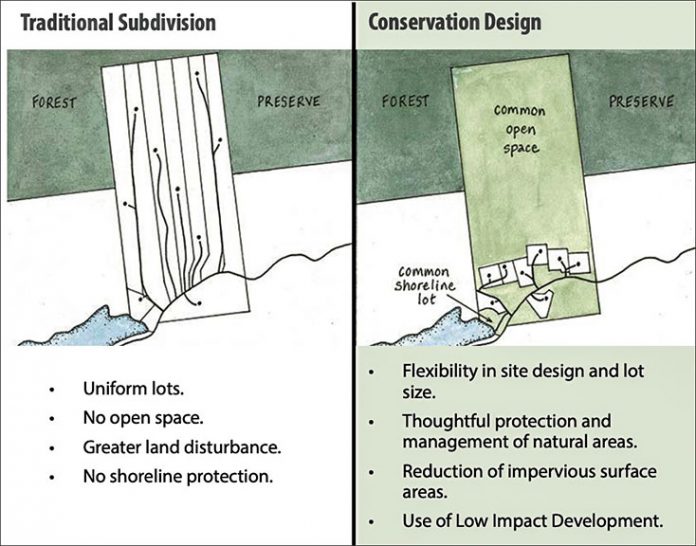
By Stefanie Jackson – The Northampton Planning Commission and Board of Supervisors discussed ongoing revisions to the county comprehensive plan during a March 24 joint work session that highlighted the continuing struggle to preserve Northampton’s rural character while allowing the development of housing and accommodations for both residents and tourists.
Northampton’s draft comprehensive plan acknowledges that tourism benefits the local economy but that tourism industry growth must be “sensitive” and “protect against displacement of existing residents.”
The delicate balance between preservation and growth was made evident as county officials discussed the public’s written comments and suggested changes for the comprehensive plan.
One way Northampton County promotes the preservation of its rural character is through its agricultural-forestal district program, which gives real estate tax breaks to owners of actively producing farm or forest lands of 200 acres or more.
A public comment on the comprehensive plan raised concern that an increasing number of farms are being sold because the family is no longer interested in farming.
Supervisor Betsy Mapp interpreted the written comment as referring to “how the number of farmers is shrinking, and they are older now, and that there’s a need for younger people in farming.”
When there’s no one left in the family to run the farm, the land is sold, but “the thing that really threatens farming is subdividing large parcels. So when you point out that many of the local family farms are one to nine acres, that’s getting to be unusable land for a farmer with big equipment,” Mapp said.
Northampton currently allows only one housing unit per 20 acres of land in rural areas traditionally used for agriculture.
Supervisor Dave Fauber suggested Northampton County incentivize the creation of cluster housing, in which several homes are grouped close together on part of a large parcel of land, and the remaining area becomes shared open space.
This type of development could be allowed through a special agreement by petitioning the planning commission and obtaining the approval of the board of supervisors.
Page 30 of Northampton’s draft comprehensive plan refers to it as “conservation design,” which differs from a traditional subdivision that is split into individual lots with no shared open space, greater land disturbance, and no shoreline protection.
On a 20-acre parcel, if two acres could be used to build 10 dwelling units, the remaining land could be used for farming, Fauber said.
“If we make clustering more attractive, then I think somebody might take us up on it,” he said.
Northampton families looking for homes also must compete with short-term rental businesses.
An anonymous writer argued that the purchase of homes for weekly vacation rentals is driving the price of homes out of range for local families. It is also difficult to find homes to rent on a monthly or yearly basis.
The writer stated, “Local families will be forced to leave the area or they are going to be homeless.”
“Everybody has issues with this one way or another, but at the end of the day, if you’re going to have an economy that’s based somewhat on tourism, you have to have short-term rentals,” said Supervisor John Coker.
Northampton supervisors defended their recent decision to allow short-term rentals by-right and rejected the anonymous suggestion to allow weekly vacation rentals only on a case-by-case basis.
However, supervisors were not interested in the recommendation of the Economic Development Authority of Northampton County to conduct a hotel feasibility study.
A summary of the recommendation stated: “The hospitality industry likely provides the county with the greatest chances for short term development. Things like hotels and restaurants are necessary to grow a tourism industry that will ultimately benefit the county budget with commercial property taxes, sales taxes, payroll taxes, hospitality taxes and related spinoff revenues.”
Another written public comment pointed out that Northampton County lacks a strategy for addressing its citizens’ housing needs.
Mapp said the Accomack-Northampton Housing and Redevelopment Corporation, part of the Accomack-Northampton Planning District Commission (A-NPDC), is already in place and by creating a new housing strategy “we would be reinventing the wheel.”
The A-NPDC encompasses two housing organizations, the Accomack-Northampton Regional Housing Alliance and the Eastern Shore of Virginia Housing Alliance, fka the Accomack-Northampton Housing and Redevelopment Corporation.
Coker insisted that Northampton supervisors must prioritize housing needs in the county. “Every year, we have teachers that want to come here but don’t because they can’t find a decent place to live,” he said.
The current draft of Northampton’s comprehensive plan recommends the county continue to participate in the Eastern Shore Regional Housing Coalition, a group that is working to bring together housing organizations on the federal, state, and local levels, in both the public and private sector.
Northampton County Administrator Charlie Kolakowski added that a request for proposals has been made to conduct a comprehensive housing needs study for the Eastern Shore, a cooperative effort of Northampton and Accomack counties and A-NPDC.


